Menus
- Gold Wing generation meeting
- 1976: Honda GL 1000 K1 Limited
- 1983: Honda GL 1100 DX
- 1986: Honda GL 1200 Aspencade SE-i
- 2001: Honda Gold Wing 1800
- 2018: Honda GL 1800 Gold Wing Tour DCT
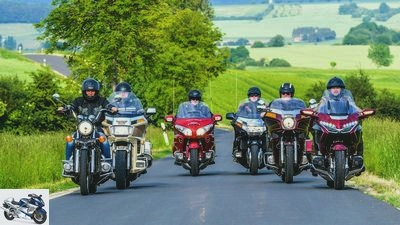
Klaus H. Daams
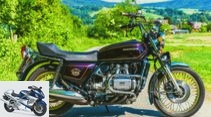
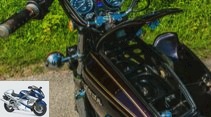
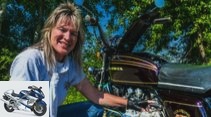
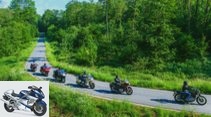
26th photos

Klaus H. Daams
1/26
This is where motorcycle history meets.
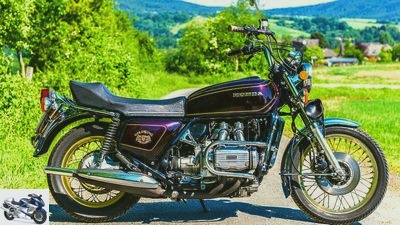
Klaus H. Daams
2/26
“LTD” insignia: Maroon paint, golden rims and eagle coat of arms. The seat is not original.
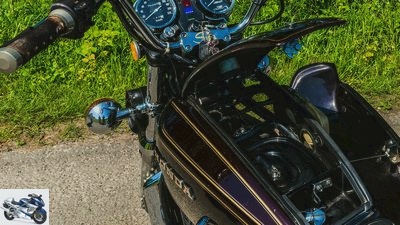
Klaus H. Daams
3/26
Open up sesame: The dummy tank with three flaps (on the side / top) contains a storage compartment, top tool and kickstarter attachment.
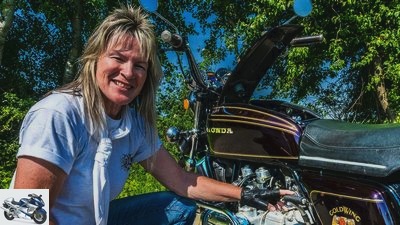
Klaus H. Daams
4/26
Carmen Geiger: I was in love with this motorcycle from the start, and I’m still fascinated and enthusiastic.
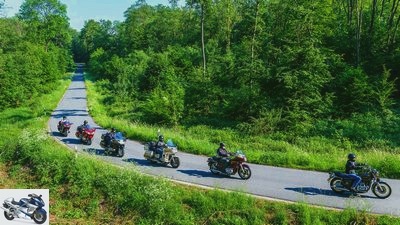
Klaus H. Daams
5/26
Recently in the Solling. The six rolling upholstered furniture can also cope with small streets.
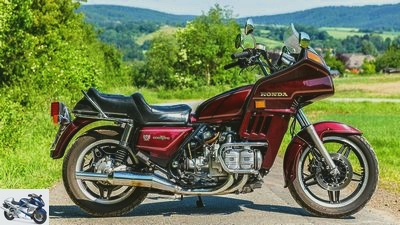
Klaus H. Daams
6/26
For good old Germany: The German version of the “Interstate” had a short disc and no suitcase.

Klaus H. Daams
7/26
In 1979, the Honda plant in Ohio started work and, from 1981, manufactured Gold Wings directly in the USA.
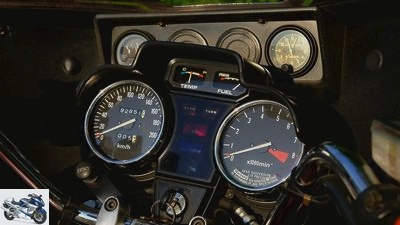
Erica Barraza Torres
8/26
Divided into two parts: speedometer, tour counter, fuel gauge, cooling water thermometer and indicator lights on the handlebar, additional information in the fairing.
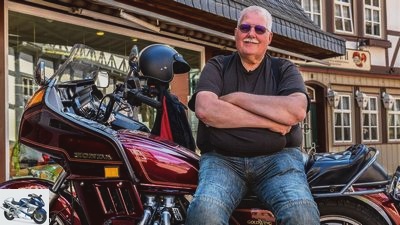
Klaus H. Daams
9/26
Urban Schmitz: I’ve been driving Gold Wings for over 35 years.
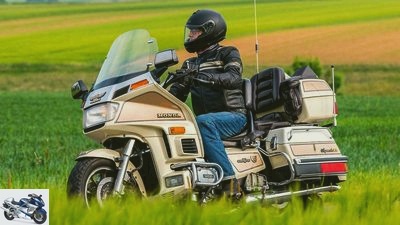
Klaus H. Daams
10/26
With all the pipapo: The moving US wing chair impresses with injection and top equipment.
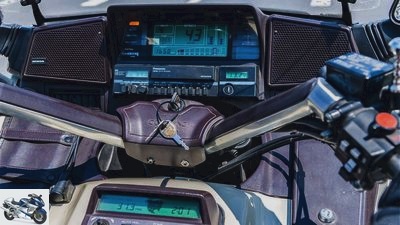
Klaus H. Daams
11/26
Messenger from the future: audio system with cassette deck and clever on-board computer including US time zones, digital tachometer, current and average consumption!
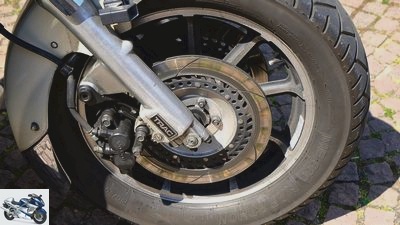
Erica Barraza Torres
12/26
Fashion of the 80s: anti-dive system (“TRAC”) and internally ventilated brake discs.
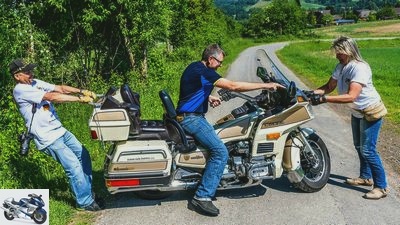
Klaus H. Daams
13/26
“All together!” There was no reverse gear on the four-cylinder models.
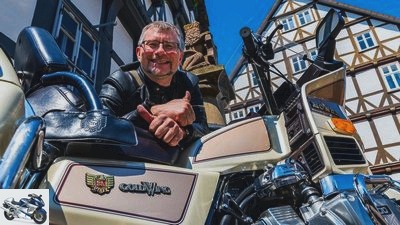
Klaus H. Daams
14/26
Thomas Schmieder: It’s hard to believe what quality this motorcycle was in the mid-80s, what standard its equipment set.
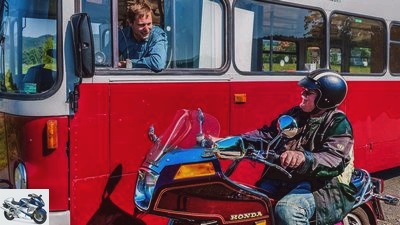
Klaus H. Daams
15/26
First registrations in 1984 among themselves: the busy Landhotel Am Rothenberg invites you to hearty tours in a double-decker convertible bus from MAN-Bussing.
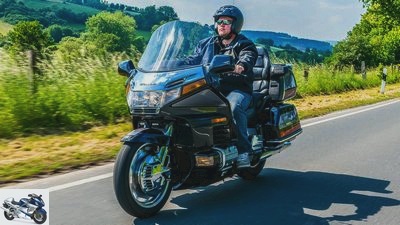
Klaus H. Daams
16/26
Even smoother: With the six-pack, despite carburettors, a new era began. Combination brake and Grand Luxe – here with US top case!
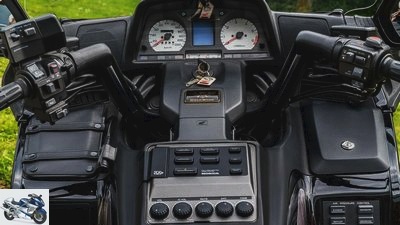
Klaus H. Daams
17/26
An ode to abundance: a flood of buttons, switches and dials required a lot of space on the tank console and XXL handlebar fittings.
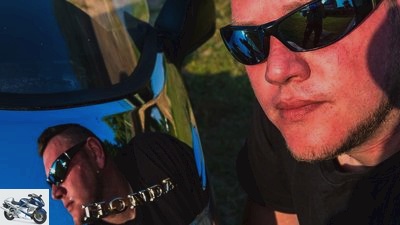
Klaus H. Daams
18/26
Dennis Kaiser: When the 1500s came out, I was eight. It’s hard to believe, today it is already a classic car.
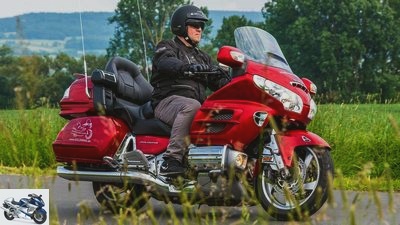
Klaus H. Daams
19/26
Much more modern: The 1800s brought modern chassis technology and ABS. Plus more steam than pounds.
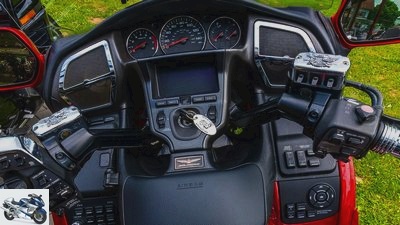
Klaus H. Daams
20/26
Over 50 switches and controls are distributed over the entire front.
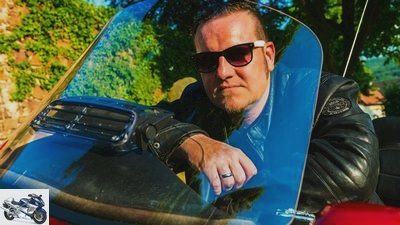
Klaus H. Daams
21/26
Sascha Moller: At first I had respect for the giant ship, but now I am enthusiastic about the driving experience and the good nature.
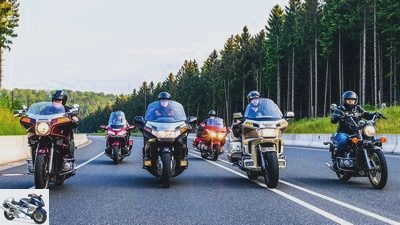
Klaus H. Daams
22/26
Elephant meeting. Even six Gold Wings combined are a very impressive appearance.
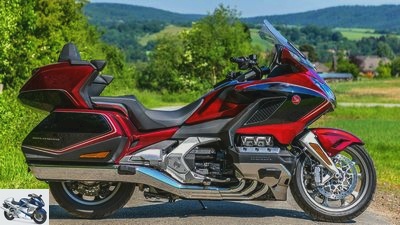
Klaus H. Daams
23/26
Long-awaited: The Winger waited 17 years for the new serve.

Klaus H. Daams
24/26
The past in view, the future in mind.
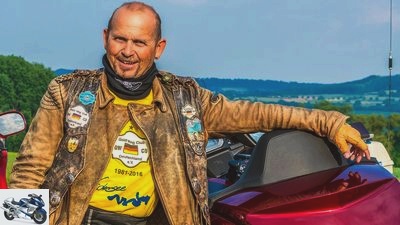
Klaus H. Daams
25/26
Reiner Schwarzkopf: The new one has not yet caught on and requires a full wallet. But the driving pleasure is enormous, the six-cylinder a stunner.

Klaus H. Daams
26/26
Six generations and seven machines? Yes, because Tobias Fuchs is sitting on a brightly refined 1800 SC 68 (2nd from right). Individualization counts in the Winger Club.
Model history Honda Gold Wing
Gold Wing generation meeting
The Honda Gold Wing has been making motorcycle history since 1974. True to the motto “enough is never enough”, they have been setting technical highlights and equipment superlatives for a life on two wheels in abundance from the first 1000 to the current 1800. Six models came to the Gold Wing generation meeting in Uslar.
44 years ago, at IFMA 1974 in Cologne, the Honda GL 1000 with its lengthways four-cylinder boxer was a sensation. First 1000s from Japan! With water cooling – for the first time on a Japanese high-volume motorcycle, so that the rear cylinders don’t get too warm! First cardan Honda! Three disc brakes! Hallelujah, what a motorcycle. “The presentation of the Gold Wing was like an earthquake, ”recalls veteran Franz Josef Schermer, MOTORRAD’s head of testing at the time. Standing on a pedestal, the Über-Honda cast a spell over the masses for a list price of 9,268 marks. Big, heavy and powerful. “Most of the visitors stood in front of the object of their desire, gasping for breath and opening their mouths,” remembers Franz Josef Schermer. “The crowd was life-threatening, the exhibition hall had to be temporarily closed due to overcrowding.”
Buy complete article
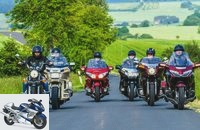
Model history Honda Gold Wing
Gold Wing generation meeting
Klaus H. Daams
The big tourers also master smaller roads in groups of six.
Honda has always been inspired by the Japanese philosophy of perfection. All Gold Wings with four or six cylinders embody this pursuit. They pamper you with legendary reliability, unconditional low maintenance and outstanding seating comfort for the entire crew. In addition, there is incomparable smoothness. But where are the subtle differences in six generations? We are investigating this in Uslar. The lovely half-timbered town with only 15,000 inhabitants is the center of the European Gold Wing world. Goldwing Fuchs constantly offers between 100 to 150 new and used machines from the 1500s: solo machines and teams, trikes with and without trailers, series bikes and rolling, completely individualized chromedies.
In over 30 years of company history, the most important Gold Wing dealer in Europe has grown up and has customers as far as Russia. Wing man Tobias Fuchs has a complete, almost without exception, ready-to-drive ancestral gallery from beginning to end. That is why he now manufactures three of the six machines, the 1200, the 1500 and the first 1800. The three other cars were provided by the Gold Wing Club Deutschland GWCD e. V. with three of its 350 members. His website www.gwcd.net offers lots of tips and information plus a detailed model history. Carmen Geiger, Urban Schmitz and “Presi” Reiner Schwarzkopf bring the 1000, 1100 and the brand new 1800 with them, thank you very much! The meeting point is the Landhotel Am Rothenberg with a magnificent 2.5 hectare garden and Kohler hut as well as convertible bus tours for a hearty celebration. But we prefer to set off with six “single-track cars” for a “visual journey” through Solling and the Weser Uplands. 30 cylinders with a displacement of almost 8.5 liters start, whispering from always bilateral, straight exhaust systems.
1976: Honda GL 1000 K1 Limited
This is not the original Gold Wing “K0” from 1975. It is a 1976 K1. It had the first improvements such as a window for checking the oil level, a grease nipple for the cardan shaft and two helmet hooks. But above all, this is a limited version, of which – depending on the source – only 1,295 to 3,000 copies were built. 500 of them came to Germany. Characteristics of the LTD: Special chestnut brown paint, golden anodized rims and spokes as well as chromed engine mounts / radiator cowling. In addition, gold stripes and logos with bald eagles on the side covers, on the occasion of 200 years of the American declaration of independence. It made sense that Carmen Geiger bought a European model with a tall US handlebar in 1986. The happy winger defends her 42-year-old naked bike: “For most people, a Gold Wing stands for huge fairings, heaps of chrome and additional headlights, and loud music.” None of the GLs from the 70s had anything ex-works.
Klaus H. Daams
This model is a 1976 K1.
Carmen has known her glider inside out for 32 years. The fuel pump behind the right cylinder bank buzzes when the ignition is switched on. It promotes the fuel, which is bunkering under the seat, to the four higher carburettors. The dummy fuel tank (the petrol meter sits on top) houses a petrol filler neck and an easily accessible limousine-like air filter as well as a large, lockable glove compartment for small items such as spare spark plugs and sunglasses. The high-quality, chrome-plated LTD on-board tool kit and a removable kick starter also rest here. “You don’t get the engine started,” reports Carmen. So then, press the button. When idling, the engine rattles and rattles, despite the one-piece forged crankshaft with plain bearings. “That is completely normal,” reassures the owner. “The primary chain elongates over time and rattles – that disappears when the engine is warm.”
The boxer still needs fine adjustment using the handy choke on the handlebars. It finally fits, the short stroke runs smoothly. Innovative: The counter-rotating alternator prevents back torque when changing gas. The silky four-cylinder pushes gently but emphatically, smoothly without hiccups, hanging gently but firmly on the gas. Cardan reactions are noticeable. Tempo 100 is at 3,500 tours in fifth gear. The aisles click through easily. This power cube from the engine weighs 106 kilograms. At the time, 82 hp was awesome for a street motorcycle. “It is obvious that this powerful motorcycle was misunderstood as a sportsman,” says Carmen.
Klaus H. Daams
The dummy tank contains a storage compartment, top tools and a kick starter attachment.
The eight-plate oil bath clutch and five-speed gearbox are innovatively located under the engine. You move the driver further forward, lower the center of gravity of the 295-kilo chunk. Who only looks delicate in comparison with his successors. The seating position on Carmen’s Guiliari bench fits perfectly (“a Kawasaki Z 1000 inspired me to this rump”): upright and confident. Touring virtues. GT with the GL. The 1000 is the only one of the six Gold Wings where you have to clean the helmet visor after the ride. The simple single-piston calipers slow down moderately at the front. After all these years, the oldie only has a good 90,000 kilometers on the clock. Carmen spares him: “If you drive too fast, the motorcycle sways.” Even back then, the chassis was considered overwhelmed in fast (motorway) bends. Man and machine could swim dangerously. Near Vmax, the magical “200” didn’t quite crack it despite full-bodied promises, some 1000s sometimes commuted terribly. “Whenever there were external disturbances, such as longitudinal grooves, lane shoulders or wake turbulence from trucks,” remembers Franz Josef Schermer. Three spectacular unencumbered accidents, one of them fatal, made the Gold Wing notorious. Handlebar-mounted fairings from Krauser were always installed, and Honda Germany advised its customers not to install them. Nevertheless, Honda had to pay compensation. Product liability.
1983: Honda GL 1100 DX
In 1980 the GL 1100 replaced the 1000 series. It met the Yamaha XS 1100, Kawasaki Z 1300 (with six-cylinder!) And Suzuki GS 1000. For sport or sport touring, Honda had the CB 900 F Bol d’Or and the Sixpack CBX 1000 at the start since 1978. So the Gold Wing could concentrate on its true purpose, mutating from a super tourer to a super tourer. Right from the start there were two new Gold Wings on an identical basis: a bare GL 1100 and for the USA, where production was complete from model year 1981, a GL 1100 Interstate, named after the local name for highways. Interstate insignia was a touring fairing in the style of its little sister CX 500 Silver Wing plus a case and top case. Factory luxury.
Klaus H. Daams
The German version of the GL 1100 DX had a short lens.
For Europe, with its more sporty driver-natures, there was a third version, the GL 1100 DX – with fairing, but without luggage boxes. Gold Wing connoisseur Urban Schmitz brought such a DX with him, an 83 with 84 initial registration. In his eventful life he already owned around 30 gold wings. “This one was actually for my wife.” In Europe, too, cases, top cases and carriers “can be ordered for 2,500 to 2,800 marks”. Urban adjusts valves with rocker arms and adjusting screws himself at home. The highlights are the DX equipment with automatic turn signal reset, two storage compartments as well as a voltmeter and timer in the cladding. The second generation sounds rich and dull, really pithy from the original, now completely chrome-plated silencers.
The drilled out engine with smaller carburettors offers more thump than the 1100s. They had the same peak power with the accelerator pump, but there are now ten Newton meters more. You can feel that despite the extra weight as a stronger push in the middle. In addition, the 1100 revs up freely, runs great. Here, too, the oldie gear shines with easy operation. Tempo 100 in fifth gear is just something between just 3,600 and 3,700 tours. A lot happened inside the engine: increased oil and cooling water volume, enlarged valves, reinforced crankshaft, new camshafts with sharper control times, stronger alternator, stable clutch and, above all, a very welcome electronic ignition.
Erica Barraza Torres
Almost 8,000 kilometers are still missing on the way to the 100,000 kilometer mark.
Double piston calipers and larger discs at the front ensure better braking performance in the 1100s. Even if they require a little hand strength. So there are now at least six stable brake pistons distributed over the motorcycle, a whopping 50 percent increase. The wide, lengthways sliding “King-and-Queen” bench seat welcomes the bottom really comfortably and comfortably. Much lower than the simple bank of the 1000s. Furthermore, the stops are deeper and the knee angle more relaxed. Fits. The curved handlebar is perfectly at hand. And the fairing effectively protects against the wind despite the windshield that was capped by the German TÜV. The chassis is more stable (flatter steering head, longer wheelbase and caster) and even more comfortable. The air-assisted suspension struts offer significantly more reserves. The tires are a very good choice: Michelin Pilot Activ were the best bias tires tested in MOTORRAD 6/2017. Honda built “Comstar wheels” in the mid / late 1970s. With them, pressed sheet metal profiles with the hub and airtight, i.e. suitable for tubeless tires, were riveted to the aluminum rim. It didn’t necessarily look high-quality, it was hardly lighter than a spoked wheel, and if the riveted joints were jolted loose, it wasn‘t repairable. Comstar wheels were already available with the GL 1000 K3 with a square tank.
1986: Honda GL 1200 Aspencade SE-i
For the last time Honda left it at the Grand with fours from 1984 to 1987, in the form of the 1200s. As early as 1982, however, the “Aspencade” model variant established itself – a homage to the Aspencade rally, a huge motorcycle meeting. It was a particularly high-quality, opulently furnished “interstate”. This included a sound system and an on-board compressor, which could be used to regulate the compressed air in the fork and the shock absorber when the vehicle was stationary. It goes without saying that the 1200s from the Fuchs’sche Museum also have such insignia. But this is a very special golden swing arm from 1986: a special edition with electronic injection only installed in 1985 and 1986 – an SE-i.
Klaus H. Daams
The GL 1200 is the first Gold Wing with maintenance-free hydraulic valve lifters.
Not at all easy to board the ivory-colored wing chair. The right leg needs to somehow be threaded past the backrest of the plush driver’s seat. Its upper edge is lower than that of the two predecessors. Done, boarded the bridge. Behind the potential passenger, a real wall unit piles up, made up of a huge topcase and storage compartments all around. Be careful, the side stand folds up by itself. The handlebars come far towards me. You could drive endlessly like this. Begin! No choke, no stress. The power cube immediately pampers you with evenly low-frequency idling. The resting heart rate of today’s 1800s is higher. In addition, the GL 1200 is the first Gold Wing with maintenance-free hydraulic valve lifters, which the six-cylinder also adopted. Let the first hydraulic clutch of the 1200s come. Simply velvety, this running culture. A four-cylinder cannot run more smoothly. It has its own charm. The shock absorber already has a memory function for individual presettings. The fifth gear is a real overdrive, an overdrive gear. Tempo 100 corresponds to only 3,050 revolutions. 94 PS and a whopping 108 Newton meters are a big plus compared to the shorter-stroke 1100. Everything is so smooth here. Damn comfortable and ami-moderately softly muffled. Quite glider. But still pump air into the shock absorber? 130 you can drive with the visor open.
Instead of 19 and 17 inches like the wheels of the 1000 and 1100, the cast rims of the GL 1200 only measure 16 inches at the front and a tiny 15 inches at the rear. She had matured, finally turned off onto the US highways. It’s a shame, no cassette with me, I still have a lot from the 80s. The Panasonic radio / cassette deck thus remains unemployed. The four speakers distributed across the front and rear can be controlled selectively. The digital dashboard from the travel computer reports all the more. What a mouse cinema: Consumption (current / average), range, remaining tank content, engaged gear, speed as a numerical value and LCD bar, oil pressure, driving time, US time zone. The speedometer shows either miles or kilometers. And of course, a cruise control is a matter of honor with this technology carrier. In the mid-1980s it was a messenger from the future, an S-Class on two wheels. The GL 1200 SE-i was never officially imported to Germany, but it was to the Netherlands. Outside of Europe there were also very naked 1200s. Of course, Fuchs has such a rare exhibit in his own museum.
Klaus H. Daams
An audio system was already on board with the 1986 model.
1988 GL 1500 SE 1988 ushered in a new Gold Wing era that lasted until the end of 2000. A six-cylinder boxer, like the original prototype, had finally made it into series production. It wasn’t just a pair of cylinders anymore. That was a new dimension of smoothness and luxury, torque and dominance. A gentle giant. And a thick ship pure, angular and imposing. The angular block was as sleek as a jaguar. It was immediately clear to all viewers: A new star had risen in the touring sky. Start the engine once and you have completely succumbed to the hoarse Porsche sound. Not loud, not intrusive, just sovereign. “Anyone who knows the six-cylinder usually doesn‘t want a four-cylinder anymore,” reports Dennis Kaiser from Goldwing Fuchs about this sensational piece of cake from an engine. When the Flat-Six is running, a euro coin placed on its edge on the tank does not fall over, according to the Winger Club. Will be true.
The crank pins of cylinders 1 and 2, 3/4 and 5/6 are each offset by 180 degrees, the three cylinder pairs are offset from one another by 120 degrees. This results in a perfectly even firing order. And only then does the turbine-like revving up. The carburetor engine is motivated and directly attached to the gas with a mixture factory on the left and right. Is it due to smaller individual cubic capacities than the 1200 quad? In percentage terms, the six-cylinder is designed with a longer stroke. Important in the here and now: the cable-operated reversing aid is on board as a maneuvering aid. The reliability of the 1500s set standards: “If this engine uses up oil, it is broken,” says Tobias Fuchs about the “still very popular” vehicle. A nominal 100 hp and 150 Newton meters were top for a touring bike. The speed level fell again to just 2,750 tours in the final fifth gear, designed as overdrive, at 100 km / h. Save nerves and fuel. At lower speeds up to the upper middle, there is real steam in the boiler.
Klaus H. Daams
There was no reverse gear back then.
This exhibit is a late example from 1999, with only 4,370 kilometers on the round clock with a white background. “That was a barn find,” says Dennis. The chassis is more stable and more precise than on the 1200s – the wheel diameters grew again, to 16 inches at the rear and 18 inches at the front. It has been the Gold Wing standard ever since. The driving comfort is impressive. However, you can tell from the front that there is a lot of load on the fork. The wheelbase is 1.70 meters. Also on board: combination brake. Attention: The Dunlop K 177 tires are a good 18 years old. And always available for a surprising slide. Hurry with a while, that’s the Gold Wing principle. The strenght is to be found in serenity. In 1988, the TÜV still swung the paragraph club: It officially only allowed machines with cut-off panes and top cases flat like a pizza box into the country. Looked poor and of little use. Even with that, the fat hunk weighed 387 kilograms. Retrofitted on this example, which is a few kilos heavier, with a US topcase including backrest and speakers, there is cornering light in front of each cylinder bank. It can be switched on using the indicator switch for better illumination.
In addition to the 1000, the 1500 is probably the gold wing with the greatest cult potential. “For many people the 1500 is THE Gold Wing at all,” says GWCD chairman Reiner Schwarzkopf. The 1500 served as an organ donor for the F6C, the coolest cruiser ever. Honda never rested, continued to develop and build the Gold Wing. Who still talks about Kawasaki Voyager, Suzuki Cavalcade or Yamaha XVZ 12 T today? The big tourers were and always remained more important for Honda.
2001: Honda Gold Wing 1800
Can a round motorcycle bend the square of the circle? Carrying a concept from the early 70s into the new millennium? Is it a paradox when it should be safer and cleaner at the same time, but also more dynamic and more active, more luxurious and more comfortable? No problem, the new Gold Wing 1800 could do that. With injection and G-Kat, ABS and plenty of electronics. Welcome to the Mehr! Torque was now at the level of a paddle wheel steamer: 167 Newton meters with only 4,000 tours; the rated power grew to 118 hp at a gentle 5,500 revolutions. That is dynamism paired with wonderful serenity. For mockers: the six-cylinder is narrower than any BMW two-cylinder boxer with just under two thirds of the displacement. Any questions? Okay, it builds longer. And when maneuvering you notice the 421 kilos, including the airbag, power-weight. A Camaro is just not a Ford Focus. Gold Wing joke? “Six-speed gearbox – five forward, one back.” The creamy flat-six starts work with a promising “Vrrrouummm”.
Klaus H. Daams
The 2001 Gold Wing brought some new features like ABS.
Disturbing vibrations never reach the driver. A Honda engineer is more likely to commit hara-kiri. From the first moment on, the Trieb-Werk serves its power in an inimitably calm and calming manner. Tempo 100 is only 2,600 tours in fifth gear designed as overdrive. Meekness meets bite. High rear wheel load allows the beefy power to be converted almost entirely into propulsion. From 3,000 tours up to the red area 6,000, the thrust is considerable. The bolide is fed up and, once in motion, conveys a lot of trust. Feels good.
The captain of the luxury liner sits perfectly integrated, only 74 centimeters deep. Honda can do ergonomics. The seat and handlebars look like they are tailor-made for you. Have you ever watched how real experts chase an 1800 through serpentines? The Gold Wing Secret? The low center of gravity of a well-balanced, well-balanced construction. Okay, on badly furrowed asphalt you can tell by the suspension elements that it is not so easy to keep such large suspended masses in the right balance. After all: the aluminum bridge frame is 11 kilos lighter than the steel construction of the 1500s. The lavish 25 liter tank, the largest in Gold Wing history, ensures perfect long-distance suitability. And the huge pane with a flap that can be opened or closed depending on the heat or cold. Mechanical slide latches for height adjustment were no longer up to date in 2001, however, when the BMW K 1200 LT and Yamaha FJR 1300 had electric discs. Positive: 150 liters of storage space in the top case and non-removable side cases.
Klaus H. Daams
With a total of 50 switches, it is easy to lose track of things.
Safe sedan chair: ABS was directly on board and, from 2006, the first airbag in a production motorcycle. Off to new horizons. Since 2012, the sleeker SC 68 variant, the Gold Wing has come back from Japan. Only the operating concept is really from yesterday – with 55 switches, buttons and knobs distributed wildly over the front and huge handlebar fittings. Only a real gear indicator is missing. Reiner from GWCD says: “For many of our members the old 1800 is still the crowning glory.” In 2017 it was no longer officially available in Germany: “Waiting for Euro 4” – the new one.
2018: Honda GL 1800 Gold Wing Tour DCT
After 17 years the expectations were high. The new Gold Wing also came into focus at MOTORRAD. With joy we threw ourselves into the endurance test over 100,000 kilometers with this motorcycle, the usual half endurance test distance would simply not be enough. More than a fifth of it has already been unwound, in three months. Respect. It is available for all ventures, as most recently in issue 16/2018 at the Alpen-Masters. Pampered all test drivers and passengers with outstanding seating comfort. And a charismatic sound, more aggressive than ever. However, the four-valve engine also runs a little rougher mechanically. This machine will stay with us for a long time with its top equipment. Therefore it is the reason, but not the reason, of the Gold Wing generation meeting. Sleek, elegant, almost “dainty”, it even opens up new groups of buyers. According to Tobias Fuchs, only around half of the customers come from older Gold Wings. With a great DCT and airbag, the top version weighs “only” 385 kilograms, less than large US tourers from Harley and Indian. With trimmed spring travel, only 109 and 104 millimeters, and the wide 200 mm tailgate, the modern basic construction makes the best in terms of suspension comfort and handling. Everything is good for easy curve swing. The smaller tank compensates for lower fuel consumption. The side cases are rugged and difficult to use, and the top case is also not overly large. “No camping table fits in there,” says Reiner. In total, Honda calls an optimistic 110 liter volume.
Klaus H. Daams
The current Hond Gold Wing is currently in the MOTORRAD endurance test.
Finally: an electrically adjustable window on board. Paradox: On the way to the Weserbergland via the A2 or A7, the newest, strongest Gold Wing of all time is theoretically the slowest. The electric throttle does not reveal the full cross-section of the individual throttle valve, top speed is limited to 180 km / h. Allegedly with regard to the temperature balance of the engine, which has been strengthened to moderate 126 hp and 170 Nm. Then why could that take five generations before? Well, free travel is a matter of luck in Germany anyway and with almost 200 every six-cylinder drinks like a hole. The on-board speed limit cannot be due to moderate straight-line stability, the golden swing arm is great up to 180 km / h. Honda’s model policy has been criticized. If you want the famous seven-speed dual-clutch transmission (it goes perfectly with this bike, like the fries with a burger), you have to say “yes” to the airbag, topcase and seven-inch navigation system with moderate menu navigation. All in all, this makes over 36,000 euros. Uff! Without a topcase and the like, it starts with a six-speed manual gearbox at a not squeamish 26,000 euros. With this pricing policy, the previous GL generations are not devalued. OK then. In 2018, 400 new Gold Wings in three model versions will be added nationwide. Around 800,000 gold wings were created in just under 44 years. The success story continues.
Related articles
-
On the move with the Honda GL 1000 Gold Wing
Jahn 11 photos Jahn 1/11 In view of the enlightening driving impressions with the Honda Gold Wing from 1977, some old prejudices have to be straightened…
-
Honda Gold Wing GL 1800 endurance test final balance
Jacek Bilski 34 photos ADAC 1/34 I’ve never taken apart an engine that looked this good, everything here looks more like 5,000 than 63,000 kilometers….
-
Harley-Davidson Electra Glide, Honda Gold Wing and Yamaha Vmax
Bilski 48 photos Bilski 1/48 Three rolling icons, sculptures on wheels, celebrate 2015 rounds Birthday. Motorcycles that almost everyone knows, together…
-
Cult bike Honda GL 1000 Gold Wing
archive 6th photos Markus Jahn 1/6 Markus Jahn 2/6 Honda 3/6 Travel motorcycle with smoothness and comfort: the Honda GL 1000 Gold Wing from 1974….
-
Luxury tourer comparison test BMW K 1600 Grand America and Honda GL 1800 Gold Wing Tour DCT airbag
17th photos 1/17 BMW K 1600 Grand America and Honda GL 1800 Gold Wing Tour DCT airbag in comparison test. 2/17…
-
Harley-Davidson Street Glide and Honda Gold Wing F6B put to the test
Gargolov 31 photos Gargolov 1/31 Shortened at the front as if with a scythe, at the back as if compressed with a hammer: excavators look strangely…
-
Honda GL 1000 Gold Wing and Munch-4 TTS-E 1200
fact 35 photos fact 1/35 Honda GL 1000 Gold Wing and Munch-4 TTS-E 1200. fact 2/35 Nevertheless, the Munch is not as inaccessible as feared. In fact, she…
-
Driving report Honda Gold Wing
Driving report Honda Gold Wing Great goodness Oh dear, now the time has come! 1.8 liter displacement, price just under 50,000 marks. The only thing…
-
New products: Honda Gold Wing, Crossrunner and CBR 300 R
Honda novelties: model presentation Well-kept models The world’s largest motorcycle manufacturer relies on proven concepts. The Gold Wing was celebrated for the 40th anniversary …
-
Comparative test of the BMW K 1200 TL against the Honda Gold Wing GL 1500 SE
Comparative test of the BMW K 1200 TL against the Honda Gold Wing GL 1500 SE Welcome “Wos d´Japana kenna, des kenna mia scho lang,” muttered the Bavarian…